
.jpg) Türkmenistan
(About - Türkmenistan, and
world
türkmens,
türkmennama) is located in
the
south-west of Central Asia, capital city is Ashgabat (wiki). Bounded by the Caspian Sea
in the west and the Amu-Darya river to the east,
Turkmenistan covers 488,100 sq. km, the second largest Central Asian (Turkic)
republic after Kazakhstan.
To the south it is fringed by the Köpet Dag range that forms a
natural border with Iran and father south-east with
Afghanistan. To the north-west Turkmenistan shares the
border with Kazakhstan and to the east with Uzbekistan.
Türkmenistan
(About - Türkmenistan, and
world
türkmens,
türkmennama) is located in
the
south-west of Central Asia, capital city is Ashgabat (wiki). Bounded by the Caspian Sea
in the west and the Amu-Darya river to the east,
Turkmenistan covers 488,100 sq. km, the second largest Central Asian (Turkic)
republic after Kazakhstan.
To the south it is fringed by the Köpet Dag range that forms a
natural border with Iran and father south-east with
Afghanistan. To the north-west Turkmenistan shares the
border with Kazakhstan and to the east with Uzbekistan.
The landscape of Turkmenistan (see districts) unfolds like a fabled
Turkmen carpet. the Caspian Sea forms
the western edge while mountain ranges fringe the southern
borders and parts east. .gif) It is surfaced by one of the largest
expanses of sand in the world: the Karakum (black sand) desert [1], and
with rich of
natural resources on places like Köýten Dag.
Türkmen alphabet
(most close to common turkic alphabet)
uses latin and consists of 30 letters,
with some specific letters like:
Ç ç, Ä ä, Ž ž, Ň ň, Ö ö, Ş ş, Ü ü, Ý ý and for
character encoding - html entities.
It is surfaced by one of the largest
expanses of sand in the world: the Karakum (black sand) desert [1], and
with rich of
natural resources on places like Köýten Dag.
Türkmen alphabet
(most close to common turkic alphabet)
uses latin and consists of 30 letters,
with some specific letters like:
Ç ç, Ä ä, Ž ž, Ň ň, Ö ö, Ş ş, Ü ü, Ý ý and for
character encoding - html entities.
The
country is divided into seven oil and gas
regions according to the
geological development of the sedimentary complex: West
Turkmen, Central Kara Kum, Beurdeshik-Khiva, Chardzhou,
Zaunguz, Murgab, Badkhyz-Karabil. One of four rivers which
is Amu-Darya, biggest one, flows in
the
east along the border with Uzbekistan.
The small
Tejen and Murgab rivers run off the eastern slopes of the
mountains and vanish in the desert, only the Etrek River
that flows into the Caspian Sea. Turkmenistan has a unique
and remarkable history.
| Daily life | Historical cities | Ashgabat | Akhalteke Horses |
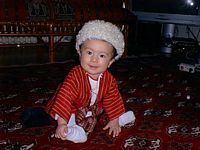
|
.gif) |
.jpg) |
.jpg) |
| Gündelikli durmuş | Taryhy şäherler | Aşgabat | Ahalteke bedewleri |
History, Prominent Figures, Ancient cities
.gif)
.jpg) Turkmenistan has a
unique and
remarkable history. The
territory of present-day Turkmenistan has been inhabited
since the Stone Age, with evidence of agricultural
communities as early as 6000 BC and of planned irrigation
works from 3500 BC. The first states were Margiana and
Parthia, from about 1000 BC. In 7th-6th centuries BC,
Margiana was part of Bactria, while Parthia was part of
the Median state. In the 6th-4th centuries BC the region
was ruled by the Achaemenids... Shortly the territory of
what is now Turkmenistan provided the bedrock for many of
the most powerful empires of their age. The Parthians, Oguzlar ancestors of Great Seljuks (Beyik Seljuklar) and the
Khans of
Khoresm all based their empires at various points on the
edge of the Kara-Kum Desert [2].
Turkmenistan has a
unique and
remarkable history. The
territory of present-day Turkmenistan has been inhabited
since the Stone Age, with evidence of agricultural
communities as early as 6000 BC and of planned irrigation
works from 3500 BC. The first states were Margiana and
Parthia, from about 1000 BC. In 7th-6th centuries BC,
Margiana was part of Bactria, while Parthia was part of
the Median state. In the 6th-4th centuries BC the region
was ruled by the Achaemenids... Shortly the territory of
what is now Turkmenistan provided the bedrock for many of
the most powerful empires of their age. The Parthians, Oguzlar ancestors of Great Seljuks (Beyik Seljuklar) and the
Khans of
Khoresm all based their empires at various points on the
edge of the Kara-Kum Desert [2].
Travel Guide for Tourists .gif)
 Turkmenistan - one of the most ancient cultural centers of
Asia. The history of Turkmenistan originates from III
century BC. For centuries the Turkmen land saw the
prosperity and fall of great empires and suffered from
ruthless conquerors. Up to the present day Turkmenistan
keeps the traces of a medieval history.
Turkmenistan - one of the most ancient cultural centers of
Asia. The history of Turkmenistan originates from III
century BC. For centuries the Turkmen land saw the
prosperity and fall of great empires and suffered from
ruthless conquerors. Up to the present day Turkmenistan
keeps the traces of a medieval history.
It's really impossible to list all possible excursion
routes across Turkmenistan. Its territory is abundant in
rare ancient monuments which have survived from ancient
times. The legendary Nissa - the residence of
Parthian kings. If you travel deeper inland you'll have a
chance to see the remains of the ancient city of Merv,
Kone Urgenc.
Capital city Ashgabat which means "the
city of love" (World's 'White-Marble' City, Record 1, Record 2) - an oasis created by
people loves hands among sands and mounts. It is a city of
blossoming parks, masterpieces of architecture,
sculptures, tremendous fountains, museums and monuments.
Besides numerous antiquities Turkmenistan has a variety of
unique natural landmarks: underground lakes, high mountain
tops, deep crevices, paradise-like places high in the
mountains are similar to none. Only in such wonderful
country you will have a chance to taste original Turkmen
delicacies from fresh mutton cooked on saxaul fire wood,
to see the world-known Akhaltekin racers, the
legendary handcrafted Turkmen carpets, to become an
eyewitness of national rituals! [3]
Art, Culture and more - Sungat we Medeniýet
.gif)
.jpg) In a culture (turkmenkultur) where the strength of the family has always
been important, weddings and the birth of children hold
the highest priority
(see
ministry of culture,
theatres). While society is
changing, the
traditional customs and rituals of the matchmaking process
and the wedding ceremony are still precisely observed.
Turkmen are renowned for their lavish hospitality, respect
for seniors, honesty and sincere generosity. To this day,
a visitor will be offered tea and food before even
being allowed to explain why he has come! Among the most
important values for the Turkmen are friendship and love,
always maintaining friendly relations with their neighbors
- it is said that "If your neighbor is happy, you
will be happy too."
In a culture (turkmenkultur) where the strength of the family has always
been important, weddings and the birth of children hold
the highest priority
(see
ministry of culture,
theatres). While society is
changing, the
traditional customs and rituals of the matchmaking process
and the wedding ceremony are still precisely observed.
Turkmen are renowned for their lavish hospitality, respect
for seniors, honesty and sincere generosity. To this day,
a visitor will be offered tea and food before even
being allowed to explain why he has come! Among the most
important values for the Turkmen are friendship and love,
always maintaining friendly relations with their neighbors
- it is said that "If your neighbor is happy, you
will be happy too."
Carpets, Akhalteke Horses, and Alabai Dogs
.gif)
 Common saying concerns horses, which Turkmen have bred and
trained for millennia: "Water is a Turkmen's
life, a horse is his wings, and a carpet is his
soul." The Turkmen's horse is virtually part of the
family and the beautiful Akhal-Teke breed is the national
emblem. The world today is home to more than 250 breeds of
horses cultivated by man over many centuries. The
Akhal-Teke is a decedent of the Turkoman horse that was
bred by the Teke tribe in the Akhal Oasis in Turkmenistan.
Akhal-Tekes are a rare exotic equine exhibiting
unparalleled grace and power.
Common saying concerns horses, which Turkmen have bred and
trained for millennia: "Water is a Turkmen's
life, a horse is his wings, and a carpet is his
soul." The Turkmen's horse is virtually part of the
family and the beautiful Akhal-Teke breed is the national
emblem. The world today is home to more than 250 breeds of
horses cultivated by man over many centuries. The
Akhal-Teke is a decedent of the Turkoman horse that was
bred by the Teke tribe in the Akhal Oasis in Turkmenistan.
Akhal-Tekes are a rare exotic equine exhibiting
unparalleled grace and power.
Turkmenistan
produces some of the most unique and beautiful carpets in
the world. Carpet weaving is an ancient art, and each
tribe developed its own distinctive pattern. In the
history or even today, because of ancient Silk Road,
carpets are sold internationally under different names
such as Bukharian or Afghan.
Turkmen carpets have been traditionally woven by women (halyçy
zenanlar), a practice that continues
today in both home settings and large-scale factories.
Turkmen dog -
Alabai is a
beautiful and courageous
animal. For many centuries it has helped Turkmen shepherds
to safeguard flocks of cattle in heavy conditions of sandy
desert. This magnificent dog can not be confused with one
other breed. Strong, well built alabai is fascinating in
its nobleness of movements, confidence and calmness. Alabai (top breed pup) can easily stand
sharp weather changes. Alabai dogs adapt both to
very hot weather, +45 degrees Celsius in shade, and to
high-mountain temperature, up to - 30 degrees Celsius.
Moreover Alabai dogs are the best friend and helper for shephared - read
Dowardarçylyk - gadymy pudak.
Always in our memory - Hemişe hakydamyzda
.gif)
Museums and books-kitaplar are said to be the best memory preservers. When you look at the new museum exhibition, or you read a book about history you realize this once again.
|
|
Books - Kitaplar (Çeper eserler pdf formatda)
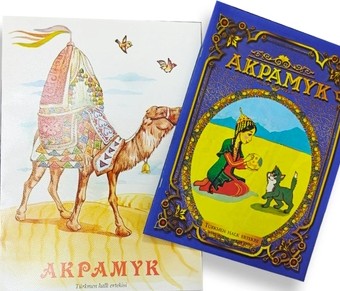 Books are my best friends. A good book is a good friend who is made by great authors.
Reading a book by an author (especially by Magtymguly
Pyragy - mp3 Ses ýazgysy bilen) you haven't read in a while - a favorite author - is something like
meeting up
with an old friend - a good friend.
Books are my best friends. A good book is a good friend who is made by great authors.
Reading a book by an author (especially by Magtymguly
Pyragy - mp3 Ses ýazgysy bilen) you haven't read in a while - a favorite author - is something like
meeting up
with an old friend - a good friend.
|
|
Library - Kitaphana (edebiýat we başga sapaklar üçin okalga)
.gif)
This section has collection of
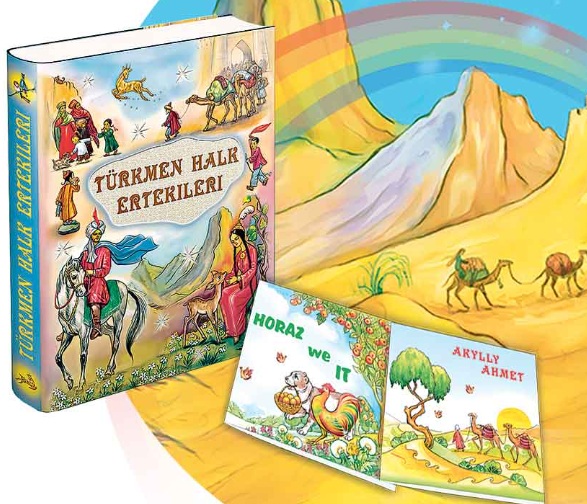 links about the Turkmen literature, language and other
related subjects e.g. see also: kitaphana,
library,
world of literature.
Turkmen literature's important well
known poet, Makhtumkuli (1733- 1813), in the 18th century,
composed mournful, painful poems about injustice, the
decline of morals and the general harshness of life. Then
came poets such as Mollanepes and Kemine whose works
remain popular among Turkmen today.
links about the Turkmen literature, language and other
related subjects e.g. see also: kitaphana,
library,
world of literature.
Turkmen literature's important well
known poet, Makhtumkuli (1733- 1813), in the 18th century,
composed mournful, painful poems about injustice, the
decline of morals and the general harshness of life. Then
came poets such as Mollanepes and Kemine whose works
remain popular among Turkmen today.
|
Tools (Gurallar) and Local Stuff .gif)
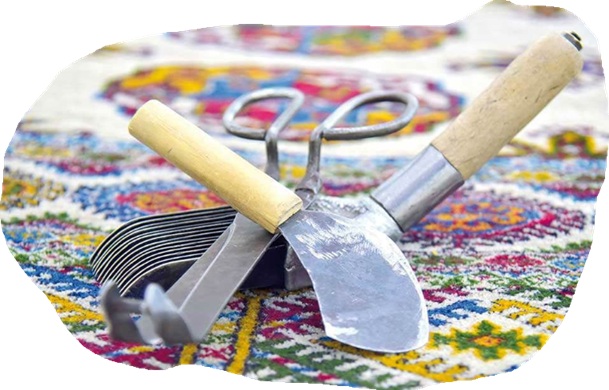
Media - Broadcasting, Music, Newspapers, Online Forums
.gif)
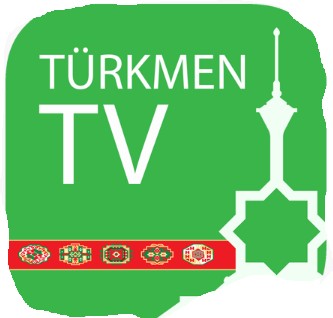
Photo, Music, and Video Galleries
.gif)
The songs
of Turkmenistan
(Türkmen aýdymlary,
mp3-list)
are connected to every aspect of life -
from lullabies to the songs children sing during their
games, to maiden's songs and wedding songs, to the
worksongs sung during camel milking and carpet weaving.
The most vibrant and respected of musicians is the
bakhshi
[Tamdyraň Heňi, Bagşynyň Owazy].
A musician-storyteller, he travels from town to
town, dressed in special clothing and carrying his own
utensils and water drawn from his own well. The villagers
will have prepared a carpet-covered platform for him and
there, by firelight, up to 2,000 people will gather to
listen as the bakhshi sings, starting before sunset and
ending long after sunrise the next morning. The bakhshi
accompanies himself on the two-stringed dutar (for halk aýdymlary)
and every
two hours he will take a short break, drinking tea and
chatting.